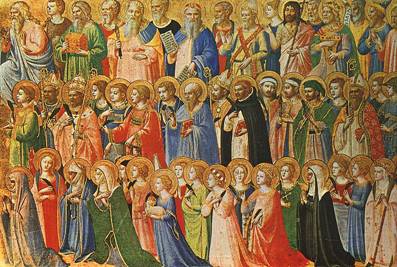Writing about Douglas Hofstadter’s Surfaces and Essences: Analogy as the Fuel and Fire of Thinking reminded me of one of the reasons I so like the Communion of Saints in the Catholic Church. We are all called to be Christ-like, but that exhortation is a little, well, enormous for me to wrap my head around on any given day. The scale of Christ’s goodness is hard for me to think about without drifting into abstraction.
But the Saints are holy men and women who seem a little closer to my day to day life. In Hofstadter’s analogy for translation, he writes:
Some of the different-colored blobs representing different languages’ coverages of a given extremely frequent concept will tend to have pretty much the same shape, but in the case of other blobs, there will be discrepancies, some minor and some major. We’ve already seen a pretty major one, involving time corresponding to heur, temps, and foisand temps corresponding to both time and weather…
Thus, the center of this conceptual space is inhabited by red and green blobs that often coincide quite well, and, when they don’t coincide, then there are all sorts of overlapping blobs, each with its own curious shape… Let’s take any shell of this conceptual space. Since languages differ enormously, we can easily find a red blog that no single green blog covers precisely. However, a small set of green blobs will collectively do a pretty good job covering all the territory of the red blob (although they will inevitably also cover areas outside the red blob)
So, I can imagine the concept-space “Christ-like” tiled with names like St. Maximilian Kolbe, St. Catherine of Siena, St Jerome, and my own St. Augustine. Each of them are closer to living out Christ’s exhortation than I am, and I can try to asymptotically approach God by approximating them.
Their sometimes very quotidian experience can be easier for me to connect to my own life. When I try to think of Christ and get muddled up, I might spend a while wondering how to be more kind to my family in the abstract or imagining various hypotheticals where I could make a very grand and cinematic sacrifice. But when I try to wonder what I could do in the manner of a saint today, I’m a little more likely to notice some paper on the floor that I can recycle or dishes I can wash.
I’m trying to answer the same question, “What would I be doing right now if I were better/nicer/kinder than I am at present” but sometimes asking it as “What would I be doing right now if I were more like St. Joan?” causes me to notice the answer much faster. For me, it’s a helpful way to counteract the tendency that C.S. Lewis describes in The Screwtape Letters to shrink God until He is easy to think about:
The humans do not start from that direct perception of Him which we, unhappily, cannot avoid. They have never known that ghastly luminosity, that stabbing and searing glare which makes the background of permanent pain to our lives. If you look into your patient’s mind when he is praying, you will not find that. If you examine the object to which he is attending, you will find that it is a composite object containing many quite ridiculous ingredients. There will be images derived from pictures of the Enemy as He appeared during the discreditable episode known as the Incarnation: there will be vaguer-perhaps quite savage and puerile-images associated with the other two Persons. There will even be some of his own reverence (and of bodily sensations accompanying it) objectified and attributed to the object revered. I have known cases where what the patient called his “God” was actually located-up and to the left at the corner of the bedroom ceiling, or inside his own head, or in a crucifix on the wall. But whatever the nature of the composite object, you must keep him praying to it-to the thing that he has made, not to the Person who has made him. You may even encourage him to attach great importance to the correction and improvement of his composite object, and to keeping it steadily before his imagination during the whole prayer. For if he ever comes to make the distinction, if ever he consciously directs his prayers “Not to what I think thou art but to what thou knowest thyself to be”, our situation is, for the moment, desperate.
Praying to the Saints, and modelling my life on theirs lets me stay small and concrete without trying to shrink God small enough for me to contain. And the Hofstadter metaphor about word-blobs seems like a nice safeguard against Protestant charges of idolatry. If St. Jerome’s cantankerousness wasn’t enough to remind me that he and God aren’t interchangeable, I can simply think that the diversity of the Saints, each of their little tiled names blobbed over God’s goodness, is like passing a jeweler’s loupe over a photo. They help magnify the details of the picture, so that I can see them, but they add nothing that was not there originally.













